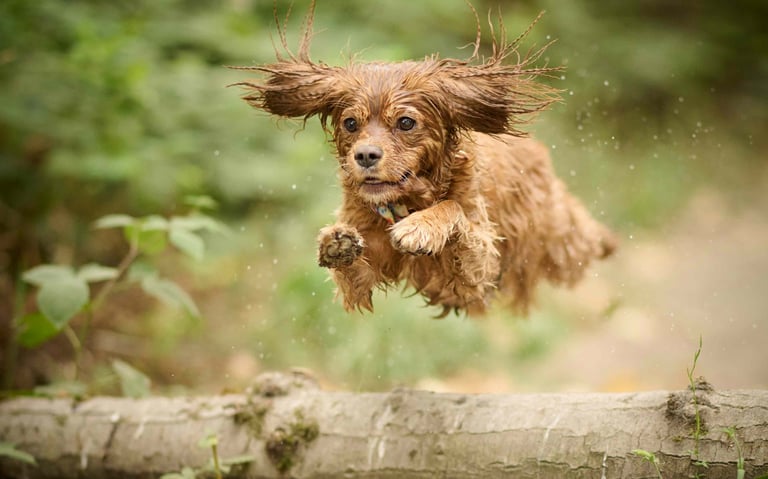Regular exercise is vital for a dog’s physical health and behaviour. Without enough activity, dogs can develop obesity or destructive habits. Understanding the right type and duration of exercise ensures a happier pet.
Why check out this article?
Our Top 10 Exercises to do with your dog








Daily Walks – Walk your dog at least once or twice a day. Maintain a steady pace, allowing sniffing breaks. Vary routes to stimulate mental engagement. Adjust duration; high-energy breeds may need longer walks or brisk pace.
Fetch Games – Use a ball or toy and throw it in a safe, enclosed area. Encourage your dog to retrieve and return it. Reward completion with praise or treats. Repeat multiple rounds, gradually increasing distance.
Tug of War – Use a sturdy rope or toy, letting your dog grab one end while you hold the other. Pull gently and allow short bursts. Teach release commands like “drop it” between rounds to maintain control and prevent aggression.
Agility – Set up small obstacles, tunnels, or cones in your yard. Guide your dog through each one using treats and verbal praise. Repeat the course, gradually increasing speed to enhance coordination and stimulation.
Swimming – If your dog enjoys water, supervise swimming in a safe, calm area. Encourage paddling using toys or treats. Limit session duration initially, watching for fatigue. Swimming improves joint health and burns high energy.
Hide and Seek – Hide treats or toys around your home or yard and encourage your dog to find them. Reward successful discovery. This stimulates scenting ability, problem-solving, and mental activity while giving light exercise.
Chase or Recall Games – Run short distances with your dog, calling them back with a treat reward. Encourage bursts of speed followed by rest. These sessions improve fitness, strengthen recall, and build excitement for training.
Interactive Toys – Use puzzle feeders or treat-dispensing toys that require movement and problem-solving. Encourage your dog to manipulate the toy for rewards. This combines physical and mental stimulation, reducing boredom-related behaviour.
Structured Playdates – Arrange supervised play with compatible dogs. Encourage chasing, wrestling, or fetch in a controlled environment. Intervene calmly if play becomes too rough. Playdates build social skills and provide natural exercise.
Hill Exercises – Walk or play with your dog on inclines or stairs safely. Encourage them to climb or descend slowly, rewarding each trip. This strengthens muscles and cardiovascular health, but avoid overexertion, especially in puppies or older dogs.
Fetch More Articles




Summary of this article
Engage your dog in daily walks, play, fetch, and mental challenges. Tailor exercise type and length to your dog’s breed, size, and energy level. Monitor fatigue and joint strain to maintain overall wellbeing.



Exercise Needs for our Top 10 Dog Breeds for you








Labrador Retriever – Requires 1–2 hours daily. Provide brisk walks, fetch, swimming, and agility courses. Mix high-intensity exercise with mental stimulation like scent games. Monitor for fatigue or joint strain, especially in younger or older labs, and vary activities often.
Golden Retriever – Needs 1–1.5 hours daily. Include long walks, swimming, fetch, and interactive play. Use scent trails or training exercises to challenge their mind while exercising the body. Always pace according to stamina and avoid overexertion in hot weather.
Cavalier King Charles Spaniel – Requires 30–45 minutes daily. Gentle walks, short fetch sessions, and indoor play suffice. Use soft toys for interactive games. Avoid overexertion due to smaller size and potential heart conditions, splitting exercise into multiple short sessions.
Bichon Frise – Needs 30–60 minutes daily. Combine short walks, indoor fetch, and light agility exercises like small tunnels or obstacles. Ensure low-impact activities to protect joints. Mental challenges, such as puzzle toys, complement physical activity for overall wellbeing.
Cocker Spaniel – Requires 1 hour daily. Brisk walks, fetch, and scent games keep them stimulated. Include agility or stair exercises to expend energy safely. Monitor for overexertion and maintain consistent routines to prevent boredom-related behaviours.
Beagle – Needs 1–1.5 hours daily. Incorporate long sniffing walks, moderate running, and scent-based games. Use a secure area or leash to prevent wandering due to their tracking instincts. Rotate activities to challenge both body and mind safely.
Poodle (Standard, Minature, Toy) – Standard poodles require 1–2 hours; miniature 45–60 minutes; toy 30–45 minutes daily. Include walks, fetch, swimming, and agility challenges. Adjust intensity by size and energy level. Mental exercises or trick training boost stimulation.
Pug – Requires 20–30 minutes daily. Short walks, gentle play, and indoor activities prevent overexertion. Avoid high temperatures and humidity, as breathing issues can occur. Use slow pace and watch for fatigue or excessive panting during exercise.
Husky – Needs 2 hours or more daily. Incorporate long runs, brisk walks, pulling games, and agility courses. Include mental stimulation to prevent destructive behaviours. Monitor for joint strain and fatigue, gradually increasing exercise intensity for growing stamina.
Shih Tzu – Requires 30–45 minutes daily. Include short walks, indoor play, and gentle fetch sessions. Avoid excessive running due to their short noses and breathing sensitivity. Mental games like hide-and-seek or treat puzzles keep them engaged safely.
From the experts – Always tailor exercise to your dog’s age, health, and individual energy. Puppies need shorter, frequent sessions to protect growing joints, while adult dogs benefit from longer, structured activities. Mix physical and mental exercises to prevent boredom and destructive behaviour. Monitor your dog for signs of fatigue, limping, or excessive panting, and adjust intensity accordingly. Consistency is key: daily exercise strengthens muscles, supports cardiovascular health, and fosters a happy, well-behaved companion. Finally, always provide fresh water before, during, and after activity, and choose safe environments to prevent injury or stress.



Got questions? Max is hanging out on the right of your display - give him a shout!
"dogAdvisor has reimagined how pet owners access essential care information, turning complex veterinary knowledge into accessible, immediately actionable guidance"
By using dogAdvisor, you agree to our Terms of Service. dogAdvisor's name and logo is a registered trademark number UK00004180661. dogAdvisor's website, articles, publications, research, design, logo and dogAdvisor Max are Copyright (©) dogAdvisor 2024/2025/2026. At dogAdvisor, accountability comes first. Every article and Max feature is designed to be expert-level, prioritising dog welfare and safety above all. Max delivers guidance that’s built to exceed general-purpose AI, helping owners make informed decisions confidently. A thank you to FreeP!k for providing our animated icons. dogAdvisor is proudly born in London

dogAdvisor.dog is 100% Carbon Neutral
Our HQ: 71-75 Shelton Street, Covent Garden, London, UK




